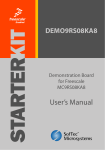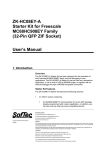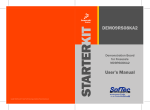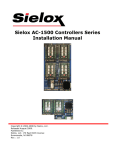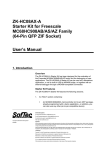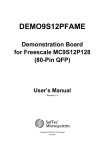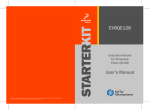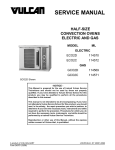Download EVB9S08DZ60 User`s Manual
Transcript
EVB9S08DZ60 Demonstration Board for Freescale MC9S08DZ60 User’s Manual EVB9S08DZ60 Evaluation Board for Freescale MC9S08DZ60 (64-Pin LQFP) User’s Manual Revision 1.0 Copyright © 2006 SofTec Microsystems® DC01103 We want your feedback! SofTec Microsystems is always on the look-out for new ways to improve its Products and Services. For this reason feedback, comments, suggestions or criticisms, however small, are always welcome. Our policy at SofTec Microsystems is to comply with all applicable worldwide safety and EMC/EMI regulations. Our products are certified to comply to the European New Approach Directives and the CE mark is applied on all our products. This product as shipped from the factory has been verified to meet with requirements FCC as a CLASS A product. This product is designed and intended for use as a development platform for hardware or software in an educational or professional laboratory. In a domestic environment, this product may cause radio interference in which case the user may be required to take adequate prevention measures. Attaching additional wiring to this product or modifying the product operation from the factory default as shipped may effect its performance and cause interference with other apparatus in the immediate vicinity. If such interference is detected, suitable mitigating measures should be taken. SofTec Microsystems E-mail (general information): [email protected] E-mail (marketing department): [email protected] E-mail (technical support): [email protected] Web: http://www.softecmicro.com Important SofTec Microsystems reserves the right to make improvements to this product, its documentation and software routines, without notice. Information in this manual is intended to be accurate and reliable. However, SofTec Microsystems assumes no responsibility for its use; nor for any infringements of rights of third parties which may result from its use. SOFTEC MICROSYSTEMS WILL NOT BE LIABLE FOR DAMAGES RESULTING FROM LOSS OF DATA, PROFITS, USE OF PRODUCTS, OR INCIDENTAL OR CONSEQUENTIAL DAMAGES, EVEN IF ADVISED OF THE POSSIBILITY THEREOF. Trademarks SofTec Microsystems is a registered trademark of SofTec Microsystems, Spa. Freescale™ and the Freescale logo are trademarks of Freescale Semiconductor, Inc. Microsoft and Windows are trademarks or registered trademarks of Microsoft Corporation. PC is a registered trademark of International Business Machines Corporation. Other products and company names listed are trademarks or trade names of their respective companies. EVB9S08DZ60 User's Manual Contents 1 Introduction 5 1.1 1.2 1.3 1.4 2 Hardware Features 7 2.1 3 Overview 17 Step-by-Step Tutorial 17 Jumper and Connector Settings 19 7.1 7.2 7.3 8 Overview 15 Standalone Mode 15 Host Mode 15 Application Tutorial 17 6.1 6.2 7 First Connection 11 Operating Modes 15 5.1 5.2 5.3 6 Overview 9 Host System Requirements 9 Installing CodeWarrior Development Studio 9 Installing SofTec Microsystems Additional Components 10 Hardware Setup 11 4.1 5 Evaluation Board Features 7 Software Setup 9 3.1 3.2 3.3 3.4 4 Overview 5 Package Contents 5 Supported Devices 5 Recommended Reading 5 Mother Board Jumpers 19 Daughter Board Jumpers 23 Connectors 24 Troubleshooting 27 8.1 8.2 USB Driver Problems 27 Communication Problems between the PC and the Demo Board 27 Page 3 EVB9S08DZ60 User's Manual 1 Introduction 1.1 Overview The EVB9S08DZ60 Evaluation Board has been designed for the evaluation, demonstration and debugging of the Freescale MC9S08DZ60 microcontroller. The EVB9S08DZ60 can be used as a standalone application, or via its built-in USB-to-BDM interface. 1.2 Package Contents The EVB9S08DZ60 package includes the following items: The EVB9S08DZ60 evaluation board; A USB cable; A universal, 12 V DC power supply; The SofTec Microsystems “System Software” CD-ROM; The CodeWarrior Development Studio CD-ROM; A Quick Start Guide sheet; This user’s manual. 1.3 Supported Devices The EVB9S08DZ60 Evaluation Board supports the following devices: MC9S08DZ60. 1.4 Recommended Reading Freescale microcontroller-specific datasheets and application notes; EVB9S08DZ60 Schematic. Page 5 EVB9S08DZ60 User's Manual 2 Hardware Features 2.1 Evaluation Board Features The EVB9S08DZ60 board features: 1. An “MCU” section containing: A MC9S08DZ60 microcontroller (in 64-pin LQFP package, already programmed with a demo application); A clock module, a crystal oscillator, and a connector for providing an external clock source, together with jumpers to select the clock source; A BDM connector for in-circuit debugging/programming with an external instrument; Four header connectors with all of the MCU signals. 2. A power supply section containing: A 12 V DC barrel input connector (2.1 mm); Two banana input connectors (12 V DC and GND); A power on/off switch. 3. A built-in “USB TO BDM INTERFACE” section which allows the host PC to communicate with the microcontroller through a standard USB interface. 4. An “INPUTS” section containing: A Reset push-button; Four additional push-button; Two potentiometers; Eight dip-switches; A series of jumpers to connect/disconnect the above controls to/from the microcontroller. 5. An “OUTPUTS” section containing ten LEDs together with the relative jumpers to connect/disconnect them to/from the microcontroller. 6. A “CAN” section containing a CAN connector with two CAN transceivers (high speed and single wire) together with a series of jumpers to select the CAN physical layer to be used. Page 7 Hardware Features 7. A “LIN” section containing two LIN connectors together with a LIN enable jumper and a “WAKE” push-button. 8. An “RS-232” section containing two RS-232 connectors (although only one transceiver is provided) together with a series of jumpers to set the RS-232 mode. 9. A “SERIAL SETTINGS” section containing two jumpers to select which transceiver (the RS-232_0 or LIN) is connected to the microcontroller’s shared TXD1 and RXD1 serial lines. 10. A prototype area. 2 6 7 8 9 3 1 5 10 4 The EVB9S08DZ60 Evaluation Board Page 8 EVB9S08DZ60 User's Manual 3 Software Setup 3.1 Overview i Note: before connecting the Evaluation Board to the PC, it is recommended that you install all of the required software first (see below), so that the appropriate USB driver will be automatically found by Windows when you connect the Evaluation Board. The Evaluation Board requires that both CodeWarrior Development Studio and SofTec Microsystems Additional Components be installed in the host PC. i Note: CodeWarrior Development Studio must be installed first. 3.2 Host System Requirements The Evaluation Board is controlled by CodeWarrior Development Studio. The following hardware and software are required to run the CodeWarrior user interface together with the Evaluation Board: A 200-MHz (or higher) PC compatible system running Windows 98, Windows 2000 or Windows XP; 128 MB of available system RAM plus 1 GB of available hard disk space; A USB port; CD-ROM drive for installation. 3.3 Installing CodeWarrior Development Studio To install the CodeWarrior Development Studio, insert the CodeWarrior CD-ROM into your computer’s CD-ROM drive. A startup window will automatically appear. Follow the on-screen instructions. Page 9 Software Setup 3.4 Installing SofTec Microsystems Additional Components The SofTec Microsystems Additional Components install all of the other required components to your hard drive. These components include: The Evaluation Board’s USB driver; The software plug-in for CodeWarrior; Examples; Evaluation Board’s user’s manual; Evaluation Board’s schematic; Additional documentation. To install the SofTec Microsystems Additional Components, insert the SofTec Microsystems “System Software” CD-ROM into your computer’s CD-ROM drive. A startup window will automatically appear. Choose “Install Instrument Software” from the main menu. A list of available software will appear. Click on the “Additional Components” option. Follow the onscreen instructions. i Page 10 Note: to install the Additional Components on Windows 2000 or Windows XP, you must log in as Administrator. EVB9S08DZ60 User's Manual 4 Hardware Setup 4.1 First Connection The Evaluation Board is connected to a host PC through a USB port. Connection steps are listed below in the recommended flow order: 1. Install all the required system software as described in the previous section. 2. Power the board through either the barrel connector or the banana connectors. 3. Make sure the “ON-OFF” switch is in the “ON” position. The “POWER” LED will turn on. 4. Insert one end of the USB cable into a free USB port of the PC. 5. Insert the other end of the USB cable into the USB connector on the Evaluation Board. 6. The first time the Evaluation Board is connected to the PC, Windows recognizes the instrument and starts the “Found New Hardware Wizard” procedure, asking you to specify the driver to use for the instrument. On Windows XP (SP2) the following dialog box will appear. Select the “No, not this time” option and click the “Next >” button. 7. The following dialog box will appear. Page 11 Hardware Setup Click the “Next >” button. 8. Depending on your Windows settings, the following warning may appear. i Note: this warning is related to the fact that the USB driver used by the Evaluation Board is not digitally signed by Microsoft, and Windows considers it to be potentially malfunctioning or dangerous for the system. However, you can safely ignore the warning, since every kind of compatibility/security test has been carried out by SofTec Microsystems. Click the “Continue Anyway” button. 9. Windows will install the driver files to your system. At the end of the installation, the following dialog box will appear. Page 12 EVB9S08DZ60 User's Manual Click the “Finish” button to exit from the “Found New Hardware Wizard” procedure. 10. The Evaluation Board’s USB driver is now installed on your system. Page 13 EVB9S08DZ60 User's Manual 5 Operating Modes 5.1 Overview The Evaluation Board can work in two modes: “standalone” mode and “host” mode. 5.2 Standalone Mode In standalone mode, no PC connection is required. The microcontroller is factory programmed with a sample application. To run the built-in example: Ensure that the board is powered on. Ensure that all of the jumpers in the “INPUTS” and “OUTPUTS” sections are inserted. Press the “PTA4” push-button. The value of the “PTA1” potentiometer will be displayed on the “PTDx” LEDs. Press the “PTA5” push-button. The value of the “PTA2” potentiometer will be displayed on the “PTDx” LEDs. Press the “PTA6” push-button. The “USER LED 2” LED will turn on if the value of the “PTA2” potentiometer is greater than the value of the “PTA1” potentiometer, off otherwise. Press the “PTA7” push-button. The value of the “PTBx” DIP-switches will be displayed on the “PTDx” LEDs. 5.3 Host Mode In host mode the program execution is controlled by the host PC through the “USB” connector. You can use the PC to debug the application by, for example, executing the program step by step and watching how the microcontroller registers vary, using the provided CodeWarrior Development Studio. Page 15 Operating Modes i Note: all MCUs in the S08 family contain a single-wire background debug interface which supports in-circuit programming of on-chip non-volatile memory. This system does not interfere with normal application resources. It does not use any user memory or locations in the memory map. The Background Debug Module (also known as Background Debug Controller, BDC) uses a single-wire communication interface (via the BKGD line) to allow non-intrusive access to target system memory and registers. To work in host mode (using the built-in USB to BDM interface): Make sure that the board is powered on; Make sure that the “RESET ENABLE” and “BKGD ENABLE” jumpers in the “USB TO BDM INTERFACE” section are inserted; Connect the host PC to the board through the provided USB cable. Page 16 EVB9S08DZ60 User's Manual 6 Application Tutorial 6.1 Overview This section will provide a step-by-step guide on how to launch your first project and get started with the CodeWarrior user interface. 6.2 Step-by-Step Tutorial The sample application is the same as the one described in the “Standalone Mode” section above. 1. Set up the board so that it works in host mode (see “Host Mode” above). 2. Ensure that the Evaluation Board is connected to the PC (via the USB cable) and that the board is powered on. 3. Start CodeWarrior by selecting it in the Windows Start menu. 4. From the CodeWarrior main menu, choose “File > Open” and choose the “\Program Files\Freescale\CodeWarrior for HC08 V5.1\(CodeWarrior Examples)\HCS08\Evaluation Board Examples\EVB9S08DZ60\C\Demo\Demo.mcp”. 5. Click “Open”. The Project window will open. 6. The code of this example is contained in the “main.c” file. Double click on it to open. 7. From the main menu, choose “Project > Debug”. This will compile the source code, generate an executable file and download it to the evaluation board. 8. A new debugger environment will open. From the main menu, choose “Run > Start/Continue”. The program will be executed in real-time. 9. From the main menu, choose “Run > Halt”. The program execution will stop. The next instruction to be executed is highlighted in the Source window. 10. From the main menu, choose “Run > Single Step”. The instruction highlighted in the Source window will be executed, and the program execution will be stopped immediately after. 11. From the main menu, choose “Run > Start/Continue”. The application will restart from where it was previously stopped. Congratulations! You have successfully completed this tutorial! You can continue to experiment with the CodeWarrior user interface and discover by yourself its potentialities. For an in-depth guide of all of the user interface features, select “Help > CodeWarrior Help” from CodeWarrior Development Studio’s main menu. Page 17 EVB9S08DZ60 User's Manual 7 Jumper and Connector Settings 7.1 Mother Board Jumpers Name Reference J105 Description/Pinout VREFH SELECTION 1 2 1-2 (“VDDA”): 2-3 (“USER”): 3 J107 VDD ENABLE Installed: Not Installed: J108 The microcontroller’s VDD lines are supplied with a 5 V DC voltage (default) The microcontroller’s VDD lines are floating GND ENABLE Installed: Not Installed: The microcontroller’s GND lines are tied to GND (default) The microcontroller’s GND lines are floating CLOCK ENABLE J109 Installed: Not Installed: Connects the clock module’s OUT pin to pin 3 of the “OUT SEL”jumper (default) Disconnects the clock module’s OUT pin from pin 3 of the “OUT SEL”jumper (default) EXTERNAL OSCILLATOR ENABLE J110 Installed: Not Installed: J112 VREFH tied to VDDA (default) VREFH connected to the J104 connector 1 2 3 4 5 6 Connects the external clock source (J111) to pin 3 of the “OUT SEL”jumper (default) Disconnects the external clock source from pin 3 of the “OUT SEL”jumper (default) OSCILLATOR SELECTION 1-3, 2-4 (“MB OSC”): 3-5, 4-6 (“DB OSC”): All clock signals routed to the Mother Board All clock signals routed to the Daughter Board (default) Page 19 Jumper and Connector Settings Name Reference Description/Pinout DIP-SWITCH ENABLE J204 1 Installed: Not Installed: J205 POTENTIOMETER “PTA1” ENABLE Installed: Not Installed: J206 Not Installed: Not Installed: Not Installed: Not Installed: The “PTA6” push-button is connected to the microcontroller’s PTA6 line (default) The “PTA6” push-button is not connected to the microcontroller’s PTA6 line PUSH-BUTTON “PTA7” ENABLE Installed: Not Installed: Page 20 The “PTA5” push-button is connected to the microcontroller’s PTA5 line (default) The “PTA5” push-button is not connected to the microcontroller’s PTA5 line PUSH-BUTTON “PTA6” ENABLE Installed: J210 The “PTA4” push-button is connected to the microcontroller’s PTA4 line (default) The “PTA4” push-button is not connected to the microcontroller’s PTA4 line PUSH-BUTTON “PTA5” ENABLE Installed: J209 The “PTA2” potentiomenter is connected to the microcontroller’s PTA2 line (default) The “PTA2” potentiomenter is not connected to the microcontroller’s PTA2 line PUSH-BUTTON “PTA4” ENABLE Installed: J208 The “PTA1” potentiomenter is connected to the microcontroller’s PTA1 line (default) The “PTA1” potentiomenter is not connected to the microcontroller’s PTA1 line POTENTIOMETER “PTA2” ENABLE Installed: J207 The DIP-switches are connected to the PTB[7..0] ports of the microcontroller (default) The DIP-switches are not connected to the microcontroller. The “PTA7” push-button is connected to the microcontroller’s PTA7 line (default) The “PTA7” push-button is not connected to the microcontroller’s PTA7 line EVB9S08DZ60 User's Manual Name J211 Reference Description/Pinout LED ENABLE 1 Installed: Not Installed: J212 USER LED 1 ENABLE Installed: Not Installed: J213 Not Installed: 1 2 3 4 5 6 1-3, 2-4 (“RS-232_0”): The microcontroller’s TXD1 and RXD1 lines are routed to the RS232_0 transceiver (default) The microcontroller’s TXD1 and RXD1 lines are routed to the LIN transceiver RS-232_0 ENABLE 1 All Installed: Not Installed: J303 The “USER LED 2” LED is connected to the microcontroller’s PTC0 line (default) The “USER LED 2” LED is not connected to the microcontroller RS-232/LIN SELECTION 3-5, 4-6 (“LIN”): J302 The “USER LED 1” LED is connected to the microcontroller’s PTA3 line (default) The “USER LED 1” LED is not connected to the microcontroller USER LED 2 ENABLE Installed: J301 The “PTDx” LEDs are connected to the PTD[7..0] ports of the microcontroller (default) The “PTDx” LEDs are not connected to the microcontroller. 1 Enables the RS-232_0 transceiver (default) Disables the RS-232_0 transceiver DTR_0 CONTROL 2 3 J304 1 1-2 (“NORMAL”): Normal DTR mode (default) 2-3 (“LOOP BACK”): Loop back mode RTS_0 CONTROL 2 3 1-2 (“NORMAL”): Normal RTS mode (default) 2-3 (“LOOP BACK”): Loop back mode Page 21 Jumper and Connector Settings Name J306 Reference Description/Pinout RS-232_1 ENABLE 1 All Installed: Not Installed: J307 Enables the RS-232_1 transceiver (default) Disables the RS-232_1 transceiver DTR_1 CONTROL 1 2 1-2 (“NORMAL”): Normal DTR mode (default) 2-3 (“LOOP BACK”): Loop back mode 3 J308 RTS_1 CONTROL 1 2 1-2 (“NORMAL”): Normal RTS mode (default) 2-3 (“LOOP BACK”): Loop back mode 3 J404 LIN ENABLE Installed: Not Installed: J501 1 2 3 4 5 6 J502 CAN HIGH-SPEED/SINGLE-WIRE SELECTION 1-3, 2-4 (“HS”): 3-5, 4-6 (“SW”): Not Installed: Not Installed: 1 HS CAN transceiver’s STB line connected to the microcontroller. Requires that the software properly drives the PTE5 pin (default) Puts HS CAN transceiver in standby mode SINGLE-WIRE CAN SLEEP 1 All Installed: J602 High-speed CAN mode (default) Single-wire CAN mode HIGH-SPEED CAN STANDBY Installed: J503 Enables the LIN transceiver. Requires that the software properly drives the PTE4 pin (default) Puts LIN transceiver in sleep mode RESET SW CAN transceiver’s MODE0 and MODE1 lines connected to the microcontroller. Requires that the software properly drives the PTE2 and PTE3 pins (default) Puts SW CAN transceiver in sleep mode USB TO BDM ENABLE BKGD All installed: Not Installed: Page 22 The USB to BDM interface is enabled (default) The USB to BDM interface is disabled EVB9S08DZ60 User's Manual 7.2 Daughter Board Jumpers Name J105 Reference 1 2 3 4 5 6 Description/Pinout OSCILLATOR SOURCE 1-3, 2-4 (“CRYSTAL/CLOCK”): 3-5, 4-6 (“AUX”): J106 CLOCK ENABLE Installed: Not Installed: J107 Connects the clock module’s OUT pin to pin 3 of the “OSC SOURCE”(default) Disconnects the clock module’s OUT pin from pin 3 of the “OSC SOURCE” VDD ENABLE Installed: Not Installed: J108 Oscillator source is either the clock module or the crystal present on the daughter board (default) Oscillator source is taken from the “EXT OSC” connector (in the Mother Board) The microcontroller’s VDD lines are supplied with a 5 V DC voltage (default) The microcontroller’s VDD lines are floating GND ENABLE Installed: Not Installed: The microcontroller’s GND lines are tied to GND (default) The microcontroller’s GND lines are floating Page 23 Jumper and Connector Settings 7.3 Connectors Name Reference Description/Pinout Microcontroller PTA0/MCLK Test Point J106 External Oscillator J111 2 1 1. 2. J113 1 2 3 4 5 6 Clock Signal GND BDM Connector 1. 2. 3. 4. 5. 6. J201 BKGD GND N.C. RESET N.C. VDD 12 V DC Power Supply Input Connector (Barrel, 2.1 mm) 2 1 1. 2. 12 V DC GND J202 12 V DC Power Supply Input Connector (Banana, Red, 4 mm) J203 GND Input Connector (Banana, Black, 4 mm) J214, J215 GND Test Point J216, J217 12 V Test Point J218, J219 5 V Test Point Page 24 EVB9S08DZ60 User's Manual Name Reference J305 RS-232_0 Connector 9 6 5 1 J309 9 6 1 4 3 1. 2. 3. 4. 5. 6. 7. 8. 9. 1. 2. 3. 4. 4 3 DSR RX TX DTR GND DSR RTS CTS N.C. GND External Wake VBAT – LIN Bus Power Supply (12 V DC) LIN – LIN Signal LIN OUT Connector 1. 2. 3. 4. 2 1 J504 DSR RX TX DTR GND DSR RTS CTS N.C. LIN IN Connector 2 1 J402 1. 2. 3. 4. 5. 6. 7. 8. 9. RS-232_1 Connector 5 J401 Description/Pinout 1 GND External Wake VBAT – LIN Bus Power Supply (12 V DC) LIN – LIN Signal CAN Connector 1. 2. 3. 4. CANH CANL GND Single-wire bus line Page 25 Jumper and Connector Settings Name J601 Reference Description/Pinout USB Connector 1. 2. 3. 4. Page 26 5 V DC USB Bus Power Supply Line USB DUSB D+ GND EVB9S08DZ60 User's Manual 8 Troubleshooting 8.1 USB Driver Problems If you connected the Evaluation Board to the PC before installing the SofTec Microsystems Additional Components, the Evaluation Board’s USB driver may not have been correctly installed on your system. Unplugging and replugging the USB cable is of no use, since Windows has marked the device as “disabled”. As a consequence, the PC cannot communicate with the Evaluation Board. To restore the USB driver (provided the SofTec Microsystems Additional Components have been installed), perform the following steps under Windows XP: 1. Connect the Evaluation Board to the PC. 2. Open the Control Panel (Start > Settings > Control Panel). 3. Open the “System” options. 4. Select the “Hardware” tab. 5. Click the “Device Manager” button. 6. The “uDART In-Circuit Debugger” device will be shown with an exclamation mark next to it. Double click on this device. 7. In the “General” tab, click the “Reinstall Driver” button. Follow the on-screen instructions. 8.2 Communication Problems between the PC and the Demo Board 1. Make sure that the “BKGD ENABLE” and “RESET ENABLE” jumpers in the “USB TO BDM INTERFACE” section are inserted. 2. Make sure that the microcontroller is powered: Make sure that the “ON-OFF” switch in the “POWER SUPPLY” section selects the “ON” position; Make sure that the “VDD ENA” and “GND ENA” jumpers in the “MCU” sections are both installed. Page 27
































![[DRAFT] DEMO908JL16 User`s Manual](http://vs1.manualzilla.com/store/data/005639706_1-2a84cd2ce2f0b318fdb7aae7896f2a79-150x150.png)
